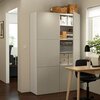I will be placing some tall cupboards (2m30ish in total) against a wall. (library image below)
They need to have attachment points at the top, into our plasterboard to stop them toppling. They are 'not' weight bearing.
Did a quick test drill; the wall is 40mm plaster (I presume acoustic plaster as it's a new(ish) build), with only 5mm cavity before the brick.
Whats your best way for attaching to the plaster?
Thanks
They need to have attachment points at the top, into our plasterboard to stop them toppling. They are 'not' weight bearing.
Did a quick test drill; the wall is 40mm plaster (I presume acoustic plaster as it's a new(ish) build), with only 5mm cavity before the brick.
Whats your best way for attaching to the plaster?
Thanks



